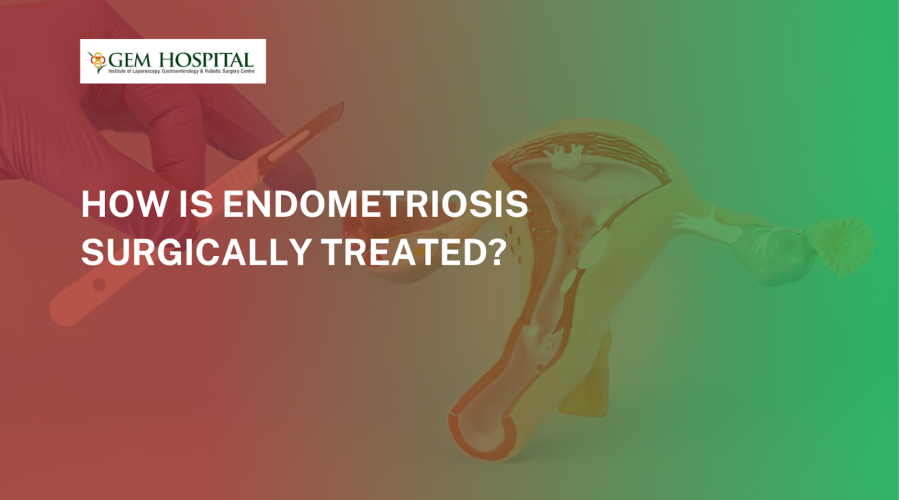Learn how to prevent jaundice during the rainy season with simple safe water practices and healthy food habits. Discover key hygiene measures, diet precautions, and monsoon safety tips to protect your liver and overall health.
How is Endometriosis Surgically Treated?

Endometriosis is a painful, and often misunderstood, condition that affects millions of women globally. Endometriosis occurs when tissue that resembles the lining of the uterus starts to grow on surfaces outside of the womb. This growth most frequently occurs on the ovaries, fallopian tubes, or lining of the pelvis. While medications and lifestyle changes can be beneficial in reducing symptoms, many women ultimately require surgical treatment for endometriosis to find long-lasting relief.
Surgery can provide a true diagnosis and effective treatment when other non-invasive options have not been successful. In this article, we will discuss how surgical treatment for endometriosis works, the different surgical techniques available, what to expect before and after surgery, and when surgery is deemed necessary.
When is Surgical Treatment Necessary?
Surgery is not the first option for every patient. Typically, doctors will recommend medications for example hormonal therapy, pain medication like anti-inflammatory analgesics, and a lifestyle change first. In some cases, surgery for endometriosis will be necessary:
- Severe pelvic pain not relieved by medication
- Infertility linked to endometriosis
- Suspicion of ovarian endometrioma (chocolate cysts)
- Adhesions or organs sticking together
- Deep infiltrating endometriosis affecting the bowel or bladder
Surgery provides a definitive diagnosis and allows for the removal of endometrial tissue, which can offer significant symptom relief and improve fertility outcomes.
Types of Surgical Treatment for Endometriosis
There are primarily two types of surgical treatment for endometriosis:
1. Laparoscopy (Minimally Invasive Surgery)
Laparoscopy is the most common way to perform surgery for endometriosis. It's a minimally invasive procedure and takes place under general anesthesia. A small camera (laparoscope) is inserted through a small incision in the abdomen, where the surgeon will view and treat endometrial lesions.
Depending on the extent and location of the tissue, the surgeon may:
- Remove (excision) or destroy (ablation) endometrial implants
- Remove ovarian cysts (endometriomas)
- Cut adhesions and free pelvic organs
- Preserve reproductive structures for fertility
Laparoscopy is the preferred surgical treatment for endometriosis due to its faster recovery, smaller incisions, and lower complication rates. Most patients return home the same day or within 24 hours.
2. Laparotomy (Open Surgery)
Laparotomy is more invasive and is considered a surgical option only in cases of complex or infiltrative disease. It requires a larger incision in the abdomen and lengthens postoperative and hospital recovery.
Though not as common today, this approach may be necessary when:
- The disease is severe and involves multiple organs
- There is extensive scarring or adhesions
- Other surgical methods are not viable
It allows better access and control in some complicated cases, though recovery time is longer compared to laparoscopy.
What Happens During Surgery?
During surgery to treat endometriosis, the intent must always be to remove or destroy the endometrial growths while avoiding damage to the normal organs. While each case of endometriosis is unique, here are the general ideas involved during surgery:
- A small incision is made near the belly button (for laparoscopy).
- Carbon dioxide gas is used to inflate the abdomen for better visibility.
- The laparoscope and surgical tools are inserted.
- Endometrial lesions are identified using magnified visuals.
- Lesions are either cut out (excision) or burnt off (ablation).
- Scar tissue or adhesions are separated.
- All instruments are removed, and the incisions are closed.
Sometimes, a biopsy may be taken during surgery for confirmation.
Recovery After Surgery
Postoperative recovery varies with different surgical modalities. For laparoscopic surgery:
- Mild abdominal pain, bloating, or shoulder pain from gas is common
- Most women resume light activity within a few days
- Full recovery usually takes 2 to 4 weeks
- Pain relief and improved menstrual symptoms may be noticed within a few cycles
Recovery for a laparotomy will probably be 6 to 8 weeks, although hospital stays are usually limited to a few days.
Long-Term Outcomes
Most women experience substantial pain relief after surgical therapy for endometriosis, particularly in the short-to-medium term. It is important to recognize that endometriosis recurs in 40–50% of the population within five years, especially if only surface lesions are excised.
A recommendation of surgery and hormone therapy after the operation is often made to reduce the risk of recurrence.
For women with problems with fertility due to endometriosis, surgery can enhance the chance of natural conception. Assisted reproductive techniques such as IVF may still be necessary in some circumstances.
Surgical treatment for endometriosis can drastically improve quality of life, alleviate pain, and enhance fertility when managed properly. It gives hope to those who have suffered for many years from undiagnosed or untreated symptoms.
At GEM Hospital we specialize in advanced laparoscopic surgery and minimally invasive surgery for gynecological conditions including endometriosis. Our team utilizes cutting-edge technology to provide safe, effective, and compassionate care.
If you or someone you know is experiencing endometriosis don’t wait; contact GEM Hospital today to Book an appointment and start your healing journey.
Blogs & Article
Understand why rainy weather may trigger gall bladder pain. Explore the causes, symptoms, and essential precautions to manage discomfort during monsoon season. Learn how humidity, diet changes, and infections influence gallbladder health.
Discover essential rainy season diet tips for patients with fissures and understand why gallbladder pain increases during the monsoon. Learn what foods to avoid, what to include, and how to maintain digestive health in humid weather.


